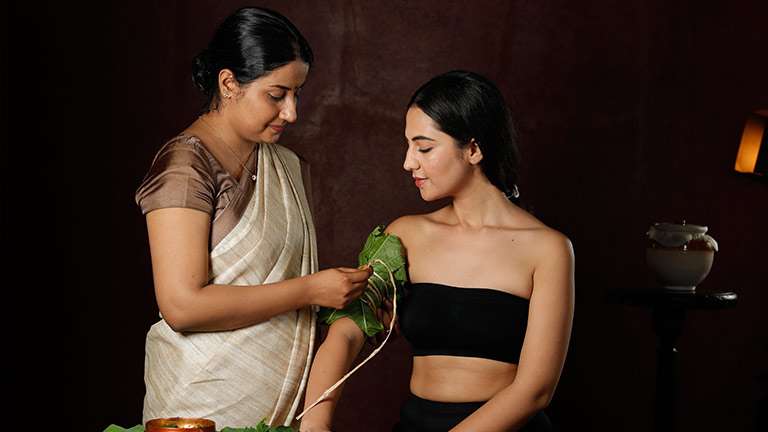Purvakarma

How do these doshas contribute to the efficacy of these panchakarma therapies?
Dosha dhatu mala moolam sada dehasya… || (A.Hr. su: 11/1)
Dosha, dhatu, and mala are the basic building blocks of the human body. When dosha, dhatu, and mala function normally, they keep us healthy. But when their functions go awry, they can lead to illnesses. Doshas are like the main ingredients of the body. They not only maintain its balance but also have the ability to disrupt it and affect other factors within the body.
There are three main doshas: Vata, Pitta, and Kapha. They either support or harm the body depending on whether they are balanced or imbalanced. Doshas can exist in different states, such as increased (vriddhi), decreased (kshaya), adhering (Leena), or excited (utklishta).
“Bahu Dosha Avastha” refers to a state where there is an excess of imbalanced doshas in the body, indicating the need for purification treatments. Symptoms associated with Bahu Dosha Avastha include issues like indigestion, loss of appetite, fatigue, eruption of pimples, and feeling weak or pale.
“Leena Dosha Avastha” means doshas that are localized or concentrated in a specific area of the body. When doshas are stuck in one place without causing disturbance elsewhere, and they are not in an aggravated state, it’s not advisable to remove them forcefully through purification treatments. It’s compared to trying to extract juice from an unripe fruit, which can lead to harm. Instead, it’s better to bring these doshas into a balanced state called “Upasthitha Dosha.”
“Upasthitha Dosha Avastha” as described by Chakrapani, involves the movement of accumulated doshas from branches to the main channels of the body. These doshas undergo transformations from a localized or stagnant state (Leena) to an active and mobile state (Utklesitha). This transformation is facilitated by preparatory treatments like cleansing of body channels and controlling the aggravation of Vata dosha
What are the preliminary steps for preparation procedures?
Dipana Pachana
“Dipana Pachana” is a process that boosts your digestion and cleanses your body’s pathways. It’s important to do this before any purification therapy because it helps to reduce toxins in the body. You can achieve this by consuming buttermilk or certain herbal medicines like vaiswanaram churnam, ashtachurnam, amruthotharam kashayam, etc. Alternatively, procedures like udwarthanam (herbal powder massage) can also help. During these treatments, your body may feel a bit dry or rough, but it’s normal and part of the process. Click here to read more about Dipana Pachana
Snehana
“Snehana” is an ancient therapy that involves applying oil or oily substances to the body. This process, also known as oleation therapy, aims to make the body more lubricated and smooth. There are two types: external (bahya) and internal (abhyantara), both of which are part of the preparatory steps (purvakarma).
External oleation includes practices like massage (abhyanga) and specific oil treatments for the head (murdhataila), such as siroabhyanga (head massage), siro pichu (head oil bath), sirovasthi (head oil pooling), and sirodhara (continuous oil flow on the forehead).
Internal oleation involves different methods. Achasnehapanam involves consuming medicated or non-medicated oils directly without mixing with food. Pravicharana snehapanam entails ingesting oils mixed with food or applying them externally, like in ear drops or massage. Sadhyasneha is when an individual quickly consumes a salty, oily drink.
These oleation methods continue until the body displays signs of proper lubrication, such as improved digestion, softness of the body, and proper movement of Vata dosha. Proper oleation also prepares the doshas to be eliminated from the body during subsequent detoxification treatments, similar to how water separates from a pot coated with oil. Click here to read more about Snehana
Swedanam
“Swedana” also known as Sudation Therapy, is a process that helps the patient to sweat. This sweating helps to move toxins (ama) trapped inside the body to places where they can be easily removed during the main Panchakarma treatment. Usually, Swedana is done after Digestion Therapy (Pachana) and Oleation Therapy (Snehana) as part of the preparatory steps (Purvakarma). However, it’s also effective as a standalone treatment.
Swedana is particularly beneficial for people dealing with conditions like asthma, weight problems, digestive issues, and inflammation in the body. It not only helps in cleansing the body but also provides relief from stress. Click here to read more about Swedanam
Need of purvakarma?
It’s challenging to remove doshas when they are in a stagnant or adhering state (amavastha). So, we need to transition the doshas from a stagnant state to an active one called Upasthitha dosha. To achieve this, options like oleation (snehana) and sweating (swedana) therapies are available.
During snehana therapy, doshas become more active (Utklesithavastha), and swedana therapy further liquefies them. Proper sweating, especially after oleation therapy, makes the body more flexible, similar to how a dry stick becomes soft and flexible when moistened. This flexibility helps the body expel the imbalanced doshas more easily during the main cleansing treatment (pradhana karma).


